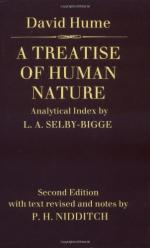|
This section contains 793 words (approx. 2 pages at 400 words per page) |

|
Book 1, Part 3, Of Knowledge and Probability Summary and Analysis
1.3 has two tasks. Hume must first given an account of knowledge and probability and distinguish them from one another. He then has to explain his conception of causation. Hume's work on belief and causation is very original and versions of his theory of causation are still popular today.
Hume is going to distinguish between knowledge and probability by bringing in the idea of philosophical relations. Relations come in two general classes - resemblance and contrariety. Ideas are either similar or dissimilar in various respects. The relation of resemblance is uncovered through comparing objects and looking for what they share and how perceptions of the objects relate to one another. Ideas can resemble on another in proportion, quantity, number, and degrees of quality. When these relations are constant, ideas resemble one another...
(read more from the Book 1, Part 3, Of Knowledge and Probability Summary)
|
This section contains 793 words (approx. 2 pages at 400 words per page) |

|




